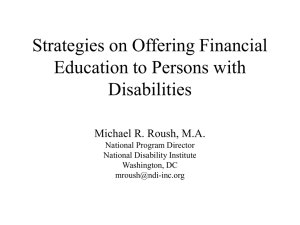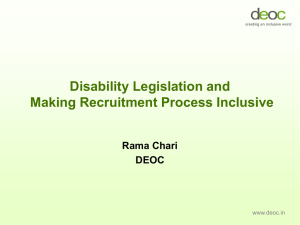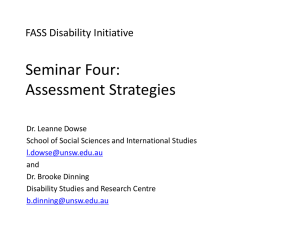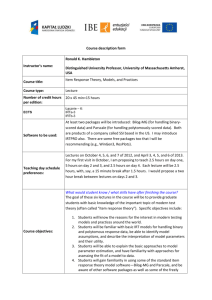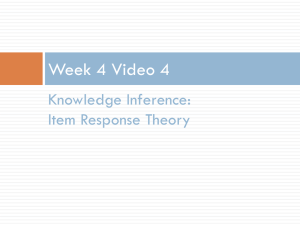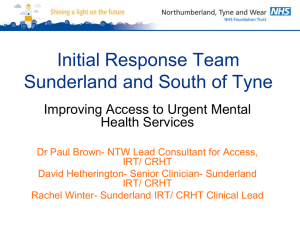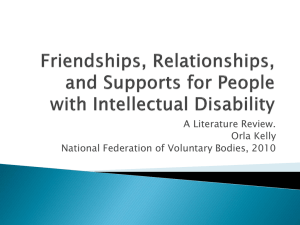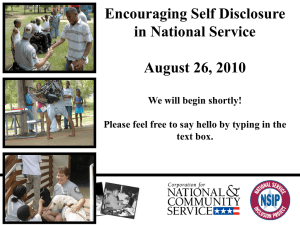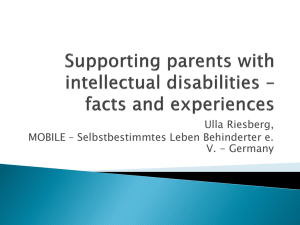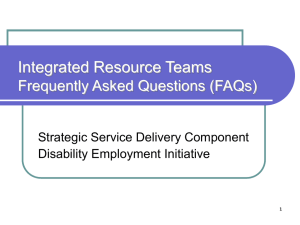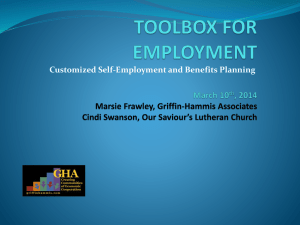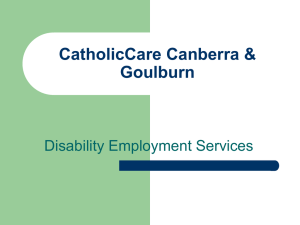Disability Etiquette
advertisement
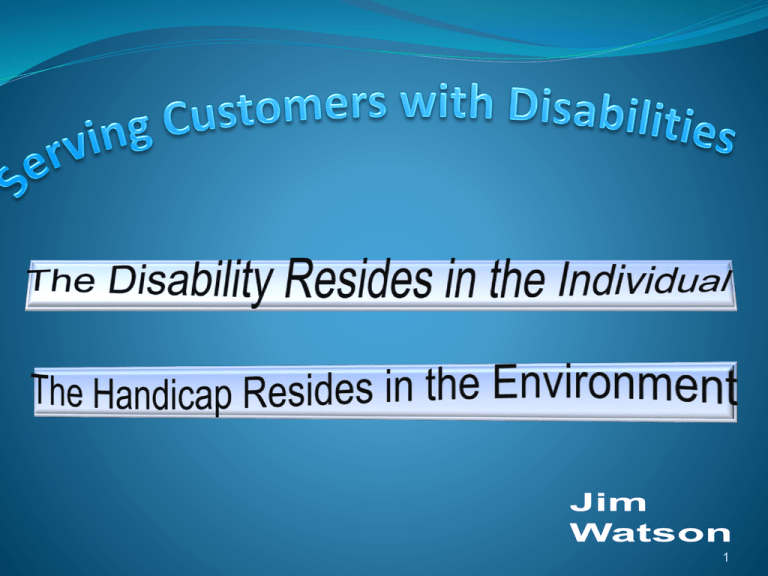
1 General Definition: Mental or physical condition that substantially limits one or more of life’s major functions SSA Definition: “the inability to engage in any substantial gainful activity by reason of any medically determinable physical or mental impairment which can be expected to result in death or which has lasted or can be expected to last for a continuous period of not less than 12 months.” 2 54 million Americans with disabilities * 15 million on SSI or SSDI 50% Deaf or Hard of Hearing 25% Mental Disabilities 2% Wheelchair users 30% of families with one or more member(s) with a disability 70% are not Employed 3 4 5 6 7 8 An IRT brings together public and private sector representatives at a local One-Stop community level. It improves communication and collaboration which results in enhanced coordination of services and supports for an individual jobseeker with a disability. 9 Members of an IRT will work together to identify and strategize how their services and resources can be coordinated to help a jobseeker with a disability reach their employment goal. The jobseeker will also be responsible for identifying their role and contributions in attaining their employment goal. 10 Enhance cross-agency collaboration and communication to better leverage available resources in a seamless way for an individual jobseeker with a disability. Increased enrollments in available workforce development programs and greater knowledge of available career options. Help the One-Stop Career Center system and partner agencies see the benefit of resource collaboration. Requires a significant culture shift, be patient, it can happen. 11 Help One-Stop staff explain the benefits of utilizing the IRT model to a jobseeker to ensure they are in agreement of needing this level of service and information sharing. Work with One-Stop staff and the jobseeker to identify and reach out to agency staff who may appropriately serve as part of the IRT. Facilitate the first IRT meeting to ensure that partners and the jobseeker are aware of the purpose of the IRT and lead the discussion to include key purposes of the IRT, such as service coordination, shared plans, communication and follow-through. 12 Since the IRT is based on the needs of the individual, the members of the team will consist of community and partner agencies and One-Stop programs that serve the needs of the individual jobseeker. An IRT may consist of members from the Workforce Investment system, the Mental Health system, the Vocational Rehabilitation system, the Independent Living Center, the Community Work Incentives Coordinator, a Supported Employment Specialist, etc. It all depends on the needs of the individual jobseeker. 13 Carlos is interested in improving his skills to earn a better wage He meets with the DPN and WIA Case Manager. View Video – 14 Jean was a TANF client and had trouble maintaining a Job. The TANF case manager invited the Navigator to the next meeting with Jean. An IRT was formed and roles of each member of the IRT were established. The IRT included Jean, the TANF case manager, a VR counselor, a Mental Health representative, an Employment Specialist and the Navigator. After three months Jean secured a full-time job with health benefits that was in line with her career choice. A year after beginning her employment Jean’s case was closed. She was receiving no benefits and had earned a merit based raise. 15 Enhance cross-agency collaboration and communication Increased enrollments in available workforce development programs and greater knowledge of available career options Increased access to four-year college education, achievement of academic certifications, apprenticeship Promote and secure financial independence for people with disabilities, and increase their knowledge about benefits and available work incentives that lead to greater empowerment and inclusion. 16 A staff per son at each center to ensure access, services and effective communication for job seekers with disabilities A point of contact for a jobseeker to request accommodations A resource and link for additional services in the community 17 Myth: People with disabilities are a small segment of the population. Fact: People with disabilities are the largest single minority in the country. The only minority in which anyone could become a member of at anytime. Myth: Disabilities begin at birth. Fact: Most people with disabilities have not been disabled for much of their lives. Only approximately 10 million out of 54 million people with disabilities acquired their disability before age 20. One out of seven adults will become disabled before reaching retirement age Paid employment and SSA disability benefits are NOT mutually exclusive It is possible to work and keep Medicaid or Medicare in almost every case It is possible to work and come out ahead financially even if benefits are reduced The object of SSA programs is to promote employment and enhance self-sufficiency SSA initiatives are NOT intended to force people off benefits, nor are they intended to help people maximize their benefits 19 If a person on SSI earns income they will not receive a SSI check. When a person is earning income, only the earnings count to stay eligible for SSI. A person may be able to earn $28,000/year in wages and still keep Medicaid When an individual is no longer receiving their SSDI payment due to work, they are also no longer eligible for Medicare All SSI and SSDI beneficiaries in cash payment status are eligible to receive a Ticket, except: Beneficiaries who are under age 18 or who are full retirement age or older; Childhood SSI beneficiaries who have attained age 18, but who have not had a redetermination under the adult disability standard. Enhanced access to services and supports from a broader array of ENs in addition to the state VR agency Protection from medical CDRs while Ticket is assigned and in use, and the beneficiary is making “timely progress” Protection from medical CDRs while accessing services from state VR agency using the cost reimbursement option, although Ticket is NOT considered to be “assigned”. “In Use” a ticket holder is using the case managed services of VR agency who is not receiving payments as an Employment Network (EN) Tickets may not be assigned to an EN while they’re “in use” “Assigned” ticket holder agrees to the services of an EN; completes and signs an IWP Tickets can only be assigned to one agency, however multiple agencies may receive “fair share “ payments for milestone outcomes Do learn where to find and recruit people with disabilities. Do learn how to communicate with people who have disabilities. Do ensure that your applications and other company forms do not ask disability-related questions and that they are in formats that are accessible to all persons with disabilities. Do relax and make the applicant feel comfortable. Do provide reasonable accommodations that the qualified applicant will need to compete for the job. Do treat an individual with a disability the same way you would treat any applicant or employee -- with dignity and respect. Do understand that access includes not only environmental access but also making forms accessible to people with visual or cognitive disabilities and making alarms and signals accessible to people with hearing disabilities. 24 Don't assume that persons with disabilities do not want to work. Don't assume that certain jobs are more suited to persons with disabilities. Don't hire a person with a disability who is not qualified to perform the essential functions of the job even with a reasonable accommodation. Don't assume that the cost of accident insurance will increase as a result of hiring a person with a disability. Don't assume that reasonable accommodations are expensive. Don't speculate or try to imagine how you would perform a specific job if you had the applicant's disability. Don't assume that you don't have any jobs that a person with a disability can do. Don't assume that your work place is accessible. 25 26 27 Provide a snapshot of current status SSI – SSDI or Concurrent Date of Onset – Date of Entitlement Next Medical Review Trail Work Months used Current Wages 28 29 30 31 32 33 34 35 The purpose of the 30-Second Trainings is that they are designed to be short, easy and fun, they are not designed to be a test but rather to increase knowledge of disability and employment related issues, they should only take about 30 seconds to review and they Include national, reputable resources for follow up information. 36 All the Video & Support files including the presentation are available for download at https://bwdb.onehub.com/floridaworkforce-summit/pages/files 37
